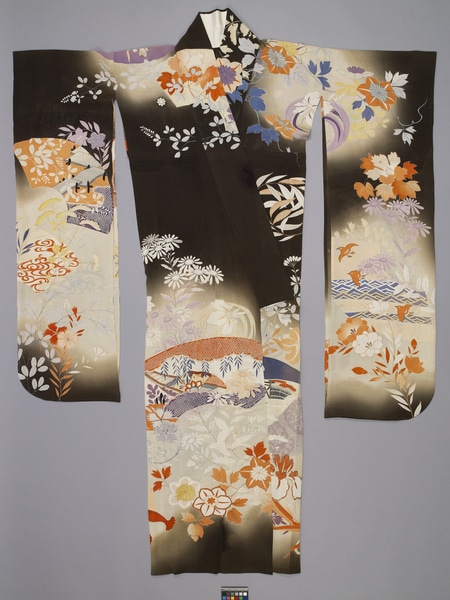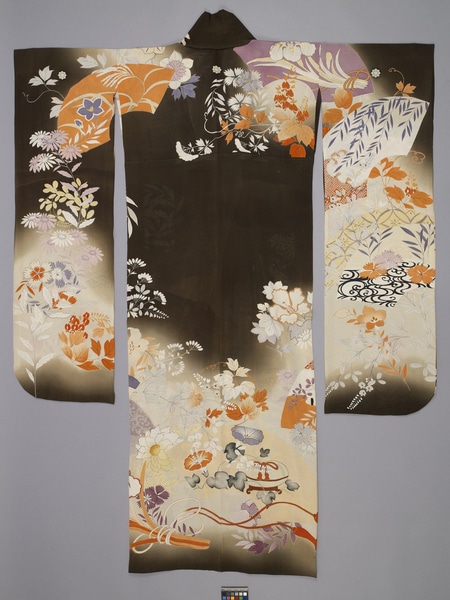Kimono Item Number: 3141/4 from the MOA: University of British Columbia


Description
Furisode (振袖) made of silk woven in a fine horizontal pinstripe. It is dyed with images of leaves, a variety of flowers, birds, trees, and elements from a garden such as buckets and stepping stones, as well as a padded stool and fan shapes scattered across a brown surface at top that fades to light tan below midpoint. At bottom some patterned elements are outlined by sliver-leaf thread. Garment is open at the front, lapels are lined with white silk, and sleeves have long hanging panels that are open toward the body. Small openings for the wrists sit at outside top. The interior of the garment and sleeves are unlined. It has five family crests or kamon (家紋) known as kuyō (九曜), one of the crests representing stars.
History Of Use
Furisode (振袖), a style of formal kimono with long swinging sleeves. There are three different types of furisode with different sleeve lengths; ō-furisode (with longest sleeves, around 115cm), chū-furisode (with long sleeves around 100cm) and ko-furisode (with shorter sleeves, around 80 cm). Ro (絽) silk was used to make formal kimonos in the past, but not much anymore. Worn by unmarried women on formal occasions.
Narrative
Purchased by donor from a Kyoto-based dealer in San Francisco.
Specific Techniques
Yuzen (友禅) dyed ro (絽) silk furisode. Ro textile is loosely woven from fine silk threads, creating sheer summer kimono. Yūzen or Yūzen-zome (友禅染) used for this kimono is a traditional dyeing technique originated in Kyoto, Japan.
Item History
- Made in Japan between 1912 and 1926
- Owned by Michael Olich before November 20, 2015
- Received from Michael Olich (Donor) on November 20, 2015
What
- Name
- Kimono
- Identification Number
- 3141/4
- Type of Item
- kimono
- Material
- silk fibre, dye, silver metal ? and mulberry paper
- Overall
- height 179.0 cm, width 132.0 cm
Who
- Culture
- Japanese
- Previous Owner
- Michael Olich
- Received from
- Michael Olich (Donor)
Where
- Holding Institution
- MOA: University of British Columbia
- Made in
- Japan
When
- Creation Date
- between 1912 and 1926
- Ownership Date
- before November 20, 2015
- Acquisition Date
- on November 20, 2015
Other
- Item Classes
- textiles
- Condition
- good
- Accession Number
- 3141/0004